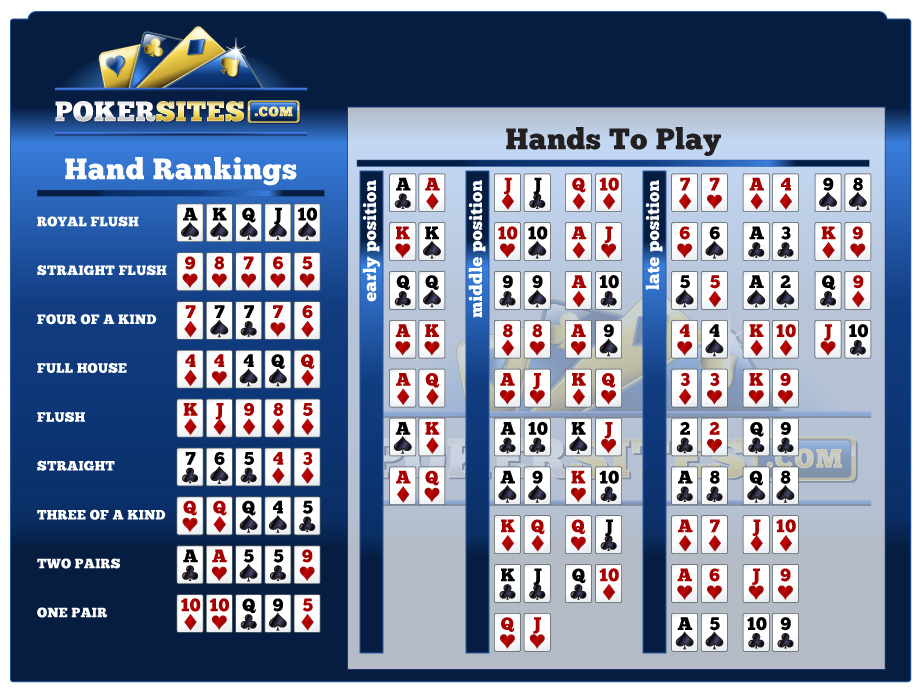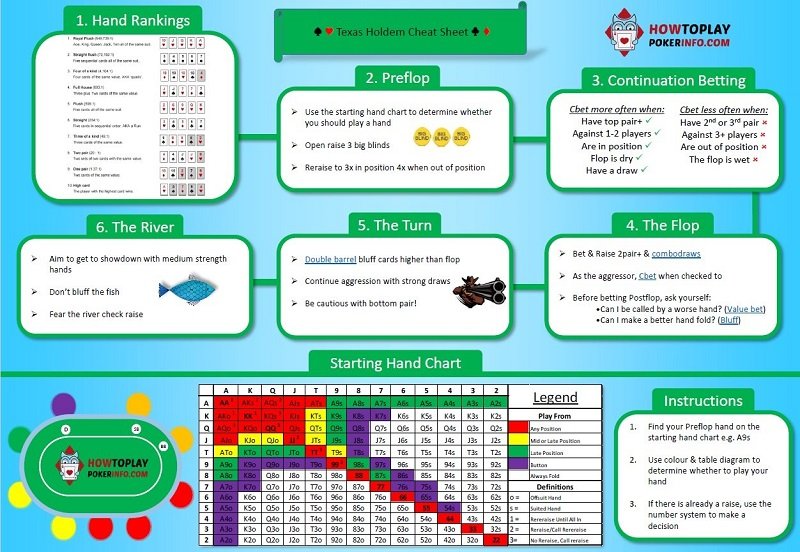Playing poker is about playing the odds. The following list gives the odds for outcomes in Texas Hold'em hands. When you realize how heavily the odds are stacked against you, you may want to rethink going all-in before the flop with two suited cards. Use the odds to your advantage:
- Hitting a flush on the flop with suited hole cards: 118 to 1 (0.8%) You will hit two pair on the flop with unpaired hole cards: 49 to 1 (2%) The Texas Hold'em odds of how likely hands are to unfold after the flop will help guide almost every action you make on the flop.
- PROBABILITY% ODDS AGAINST IT: 1: Any Pair: 5.88%: 16-1: 2: Any 2 Suited Cards: 23.53%: 3.25-1: 3: Any 2 Suited Connectors: 2.11%: 46.4-1: 4: Any 2 Offsuit Connectors: 6.33%: 14.8-1: 5: Suited Ace and King: 0.30%: 331-1: 6: Offsuited Ace and King: 0.90%: 110-1: 7: Suited Ace and Queen: 0.60%: 165-1: 8: Suited Ace and Jack: 9: Offsuited Ace and Queen: 1.81%: 54.4-1: 10: Offsuited Ace and Jack: 11: Suited Ace and 10 or less.
- Poker hands odds & outs: a crash course-guide on poker odds, pot odds, probabilities & odds charts so you can win at Texas Hold'em at the tables or online. One of the most important things that a poker player should know is what their poker odds are in a given situation.
1 percent (1-in-100): Percentage of time that no player holds an Ace or a King at a table in a 10-handed game
1 percent (1-in-100): Percentage of time that if you hold two suited cards, you'll flop a flush
6 percent (about 1-in-20): Percentage of time that five community cards will give pocket suited cards a flush
6 percent (about 1-in-20): Percentage of time that you'll be dealt a pocket pair
8 percent (about 1-in-12): Percentage of time that you'll hit at least trips after having a pair on the flop
12 percent (about 1-in-8): Percentage of time that you'll flop trips if holding a pocket pair
12 percent (about 1-in-8): Percentage of time that two more cards will flop in the same suit as a suited pocket pair
19 percent (about 1-in-5): Percentage of time that the five community cards will at least trip your pocket pair
32 percent (about 1-in-3): Percentage of time that you'll pair one of your cards on the flop (with no pocket pair)
33 percent (about 1-in-3): Percentage of time that you'll make a full house or better after having trips on the flop
35 percent (about 1-in-3): Percentage of time that you'll make a flush on the turn or river if you have four cards to a flush after the flop
Using a Poker odds Calculator. Want to know how far ahead or behind you are in a Texas Hold'em hand against one, two or more opponents? Our poker calculator is the perfect medium for finding out the odds in any given situation.
In the previous article on working out preflop hand probability, we worked out the likelihood of being dealt different combinations of starting hands before the flop.
In this article, I will cover the basics of working out the probabilities behind various possible flops. I'll go ahead and cover the probability basics first in case you missed it in the preflop probability article.
- Probability calculations quick links.
A few probability basics.
When working out flop probabilities, the main probabilities we will work with are the number of cards left in the deck and the number of cards we want to be dealt on the flop. So for example, if we were going to deal out 1 card:
- The probability of dealing a 7 would be 1/52 - There is one 7 in a deck of 52 cards.
- The probability of dealing any Ace would be 4/52 - There four Aces in a deck of 52 cards.
- The probability of dealing any would be 13/52 - There are 13 s in a deck of 52 cards.
In fact, the probability of being dealt any random card (not just the 7) would be 1/52. This also applies to the probability being dealt any random value of card like Kings, tens, fours, whatever (4/52) and the probability of being dealt any random suit (13/52).
Each card is just as likely to be dealt as any other - no special priorities in this game!
The numbers change for future cards.

A quick example.. let's say we want to work out the probability of being dealt a pair of sevens.
- The probability of being dealt a 7 for the first card will be 4/52.
- The probability of being dealt a 7 for the second card will be 3/51.
Notice how the probability changes for the second card? After we have been dealt the first card, there is now 1 less card in the deck making it 51 cards in total. Also, after already being dealt a 7, there are now only three 7s left in the deck.
Always try and take care with the numbers for future cards. The numbers will change slightly as you go along.

Working out probabilities.
- Whenever the word 'and' is used, it will usually mean multiply.
- Whenever the word 'or' is used, it will usually mean add.
This won't make much sense for now, but it will make a lot of sense a little further on in the article. Trust me.
Total number of flop combinations.
First of all, lets work out the total number of possible flop combinations. In other words, we will just be working out the probability of 'any random flop'.
To work out this probability we simply multiply the probability of 3 individual cards being dealt.
- (random card) * (random card) * (random card)
- (1/52) * (1/51) * (1/50) = 132,600 possible flops.
Pretty big combination of cards huh? However, we've omitted the fact that we know our 2 holecards, so there will be two less known cards in the deck when we are dealing the flop. So if we amend this calculation by starting at 50 instead of 52:
Texas Hold Em Poker Game
P = (1/50) * (1/49) * (1/48)
P = 1/117,600.
Better, but this 1/117,600 probability is with exact cards in order. In Texas Hold'em it does not make a difference whether the flop comes A K Q or A Q K. So to account for this we multiply this fraction by 6 (1*2*3 = 6).
P = 1/117,600 * 6
P = 1/19,600.
The order of cards on the flop makes no difference, so multiply the probability by 6 to account for this (1 * 2 * 3 = 6 - this is math probability stuff). Don't worry if you don't know why we do this, just take it as it is.
This means that the probability of the flop being A K Q in any order is 1/19,600 - which is exactly the same probability as the flop coming something like 2 5 9 in any order.
So in total there are 19,600 different possible flops in Texas Hold'em.

Texas Hold Em Poker Hands
Probability of specific flops.
To work out the probability of specific flops with the cards in any order we simply multiply the probabilities of each of those cards being dealt.
Multiply the 3 probabilities together.
So let's say we want to find the probability of flopping a heart flush.
- There are 2 hearts in our hand.
- There are 11 hearts left in a deck of 50.
P = (11/50) * (10/49) * (9/48)
P = 990/117600 = 1/119
In this example we do not need to multiply the final probability by 6. This is because the order of the cards and their probabilities are important, as the overall probabilities decrease as each heart is dealt.
Overview of working out flop probabilities.
This is a really basic article for working out flop probabilities in Texas Hold'em. Think of it as more of a taster for working out probabilities on the flop to help you get your feet wet.
If I were to continue with probabilities, I would be delving deeper in to mathematics and further away from poker. That wouldn't necessarily be a bad thing, but my maths is a bit rusty and it's not going to directly improve your game, so I'll stop for now. Maybe I'll address it in a future article, but for now this is as far as I'm going to go.
A quick example.. let's say we want to work out the probability of being dealt a pair of sevens.
- The probability of being dealt a 7 for the first card will be 4/52.
- The probability of being dealt a 7 for the second card will be 3/51.
Notice how the probability changes for the second card? After we have been dealt the first card, there is now 1 less card in the deck making it 51 cards in total. Also, after already being dealt a 7, there are now only three 7s left in the deck.
Always try and take care with the numbers for future cards. The numbers will change slightly as you go along.
Working out probabilities.
- Whenever the word 'and' is used, it will usually mean multiply.
- Whenever the word 'or' is used, it will usually mean add.
This won't make much sense for now, but it will make a lot of sense a little further on in the article. Trust me.
Total number of flop combinations.
First of all, lets work out the total number of possible flop combinations. In other words, we will just be working out the probability of 'any random flop'.
To work out this probability we simply multiply the probability of 3 individual cards being dealt.
- (random card) * (random card) * (random card)
- (1/52) * (1/51) * (1/50) = 132,600 possible flops.
Pretty big combination of cards huh? However, we've omitted the fact that we know our 2 holecards, so there will be two less known cards in the deck when we are dealing the flop. So if we amend this calculation by starting at 50 instead of 52:
Texas Hold Em Poker Game
P = (1/50) * (1/49) * (1/48)
P = 1/117,600.
Better, but this 1/117,600 probability is with exact cards in order. In Texas Hold'em it does not make a difference whether the flop comes A K Q or A Q K. So to account for this we multiply this fraction by 6 (1*2*3 = 6).
P = 1/117,600 * 6
P = 1/19,600.
The order of cards on the flop makes no difference, so multiply the probability by 6 to account for this (1 * 2 * 3 = 6 - this is math probability stuff). Don't worry if you don't know why we do this, just take it as it is.
This means that the probability of the flop being A K Q in any order is 1/19,600 - which is exactly the same probability as the flop coming something like 2 5 9 in any order.
So in total there are 19,600 different possible flops in Texas Hold'em.
Texas Hold Em Poker Hands
Probability of specific flops.
To work out the probability of specific flops with the cards in any order we simply multiply the probabilities of each of those cards being dealt.
Multiply the 3 probabilities together.
So let's say we want to find the probability of flopping a heart flush.
- There are 2 hearts in our hand.
- There are 11 hearts left in a deck of 50.
P = (11/50) * (10/49) * (9/48)
P = 990/117600 = 1/119
In this example we do not need to multiply the final probability by 6. This is because the order of the cards and their probabilities are important, as the overall probabilities decrease as each heart is dealt.
Overview of working out flop probabilities.
This is a really basic article for working out flop probabilities in Texas Hold'em. Think of it as more of a taster for working out probabilities on the flop to help you get your feet wet.
If I were to continue with probabilities, I would be delving deeper in to mathematics and further away from poker. That wouldn't necessarily be a bad thing, but my maths is a bit rusty and it's not going to directly improve your game, so I'll stop for now. Maybe I'll address it in a future article, but for now this is as far as I'm going to go.
If you're really interested in the mathematics of the game, try the book: The Mathematics of Poker by Bill Chen. It's definitely not a light read, but it's very interesting if you enjoy the maths side of the game. For other books, try the poker books section.
Other useful articles.
- Poker mathematics.
- Pot odds.
- Equity in poker.
Go back to the poker odds charts.
From acclaimed restaurants and award-winning hotels, to world-class table games and endless entertainment, Crown Rewards helps you to discover the World of Crown – and be rewarded. Just show your Crown Rewards card when you pay or play and you could earn points, which you can redeem for Crown experiences like shopping, dining, table games. Visit one of our Crown Rewards desks and validate your ID to complete your membership. STEP 2 We will send you an email with a temporary password or phone us on 1300 8 CROWN. For full details of the Crown Melbourne COVIDSafe Plan, please click here. Crown Towers, Crown Metropol and Crown Spa are now open. For further information on venue re-openings click here. Our casino has received approval to extend operations from 9 December 2020 with a range of restrictions. For further information please click here. Find out more about 24/7 gaming action at Crown Casino Melbourne with an exciting variety of table games, electronic games, competitions and more. Crown casino melbourne signature club.
Can You Afford Not To Use
Poker Tracker 4?
'I wouldn't play another session of online poker without it'
'I play $25NL, and in under 1 week PT4 had paid for itself'
Comments

